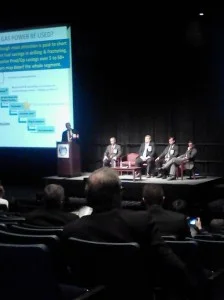The NAPE Expo is a North American event with some international influence, which features key players in the oil and gas industry. The business conference theme for 2014 was sustainability in the U.S. oil and gas industry.
The conference touched on key issues such as hydraulic fracking, sustainable business strategies and technological innovations.

Multiple speakers put a spotlight on the practice of hydraulic fracturing. Here are some of their comments:
- Former Secretary of the Interior, Ken Salazar, said, "I believe hydraulic fracking is safe... there is not a single case where fracking has caused an environmental problem for anyone."
- David Blackmon, Dir. FTI Consulting, said, "the biggest issue by far facing the industry today is water."
- "Treatment and recycling will be one of the main drivers moving the industry forward over the next 10 years," said Andrew Slaughter, VP, Upstream Research, IHS
The Business of Unconventional Drilling and Technology
- Robert Turnham, CEO, Goodrich Petroleum on business strategy: "we move early, identify opportunities and take the risk up-front. If you move early, then you enjoy lower royalty burdens straight off the top."
- Industry targeting the "sweet spots" in the shale plays. Floyd Wilson, CEO, Halcon Resources, on the Bakken: "[the company's] most recent wells in the Bakken are the best ever."
- Apache converting waste gas to electricity for field grid usage
- General industry focus on artificial lift technology in shale drilling to quickly drain reservoirs
- New diverter technology being utilized to make marginally economic wells profitable
Other Highlights from the Conference
- Luke Keller, VP, BP America, said, "[the] U.S. could achieve energy independence by 2035."
- "$2000 financial benefit to every American household by 2015 due to unconventional drilling of natural gas," according to Don McClure, VP, Government Stakeholder Relations and Legal, EnCana Oil and Gas USA
- "Tremendous amount of light sweet crude is about to be discovered and put into the marketplace [in the U.S.]" according to Charles McConnell, Rice University
- Industry encouraged to support better outreach and education initiatives via social media outlets
Learn more about NAPE by visiting napeexpo.com


